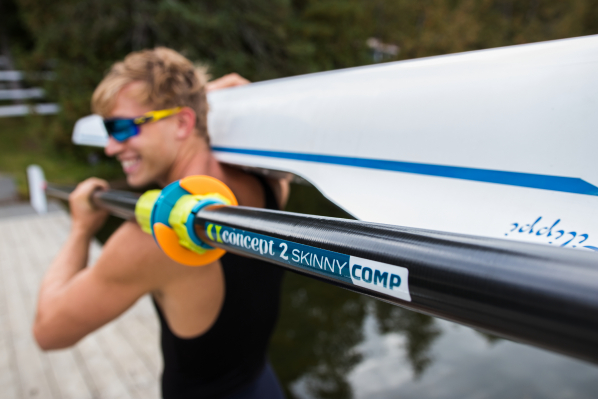Oar & Scull Care for Spring and All Year Long
 For those eagerly waiting to get back on the water to row, spring is a great time to give your oars some TLC. Pay attention to each component of your oars and sculls and you'll be out on the water in no time.
For those eagerly waiting to get back on the water to row, spring is a great time to give your oars some TLC. Pay attention to each component of your oars and sculls and you'll be out on the water in no time.
- Shafts: First make sure they are clean, then carefully inspect them, looking for any dents or cracks. Feel for soft spots on the shaft; this could indicate invisible cracks. If you can catch damage early, it will be easier to repair. It can be dangerous to row with a damaged oar.
- Blades: Clean and inspect. Small dents and delaminations can be repaired. The repair will generally be easier if caught at an early stage.
- Sleeves: Clean them thoroughly and look for signs of wear. An excessively worn sleeve can affect feathering, roll-up, and pitch, but sleeves can be replaced if need be. A clean and well-cared for sleeve will last a long time.
- Grips: A good cleaning is a great way to start the on-water season. Different grips wear at different speeds. If you have suede grips, you can easily replace the suede. Other grips will need to be replaced when the wear is such that it is affecting your comfort and grip.
We encourage you to learn how fully clean your oars and sculls. It's simple to do!
Tips for All Year Long
- Store oars and sculls in racks with the handles up, when possible. Avoid scratching blades in gravel, on concrete, and against docks and other hard surfaces. Blade damage most often occurs at the edge of the blade due to scuffing or hitting against something.
- Do not store your oars long-term in continuous sunlight. Ultraviolet light will eventually degrade the carbon surface and shorten the life of the oar.
- Transporting oars on unprotected metal roof racks can cause serious damage. Tie down oars with adequate padding, or use the Concept2 scull case for protection.
- When carrying oars to and from the dock, do not bundle them. This often leads to blades rubbing against one another in transit, and when dropped to the ground. Instead, carry one oar in each hand.
- If you must lay your oars and sculls on the ground or on a dock, lay them down with tips up to avoid wearing. Keep oars out of the way of being stepped on.
- Do not push away from the dock with your oars. Practice pushing away as a crew or walking down the dock.
- Rowing in salt water? Rinse equipment after every use. Pay special attention to sleeves, collars and oarlocks.
- Encourage teammates to report any potential damage to equipment. Even if equipment does not look broken, simple acts such as catching a crab, hitting a bridge abutment, or finding a big log in the river may lead to damage. Some rowers may be too embarrassed or nervous to report collisions, so reward athletes who speak up.
We can help you learn how to replace parts yourself. Check out our instructions and videos on our website so you can do the work on your own.
Come see us at a regatta near you!
